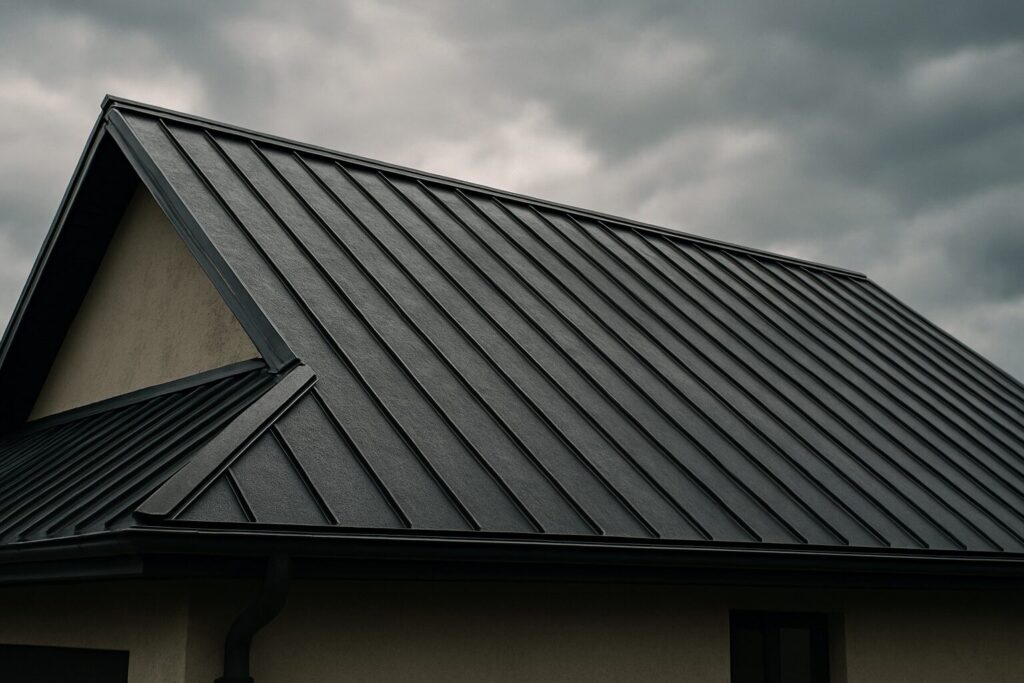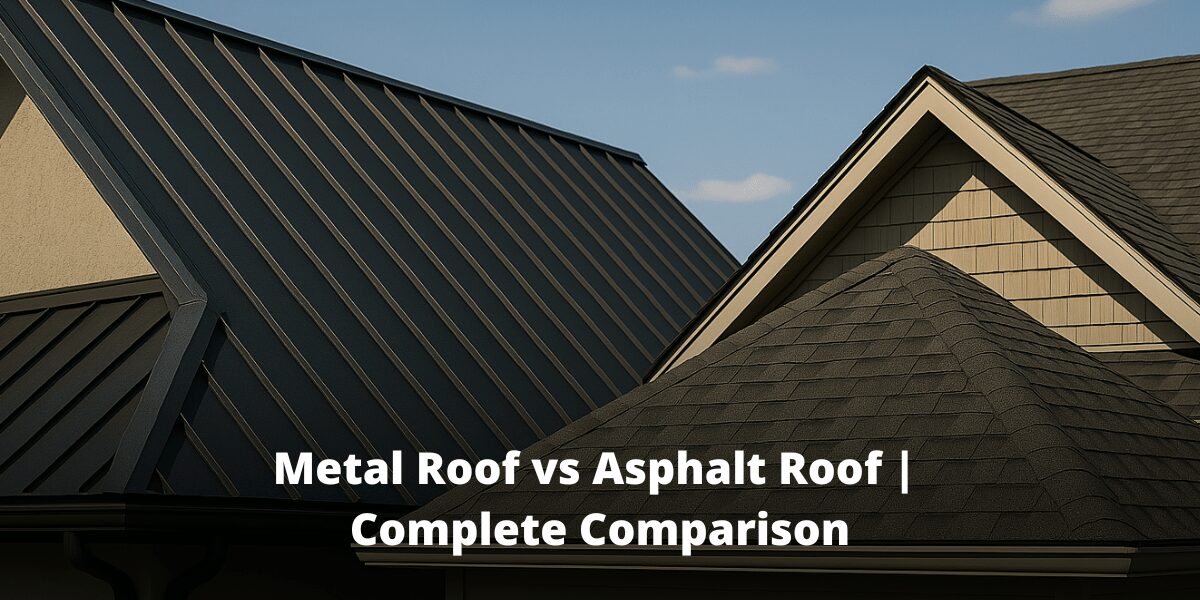One lasts decades without flinching through storms. The other blends in quietly, doing its job until it doesn’t.
Metal and asphalt roofs don’t just sit there—they shape how your home holds up, how it looks, and what you pay down the line.
If your roof’s up for replacement, this side-by-side breakdown gets you past the guesswork and into what really separates metal from asphalt.
Key Notes
- Metal roofs last 40-70 years while asphalt lasts 15-30 years.
- Metal reflects heat, cutting cooling costs by up to 25%.
- Asphalt offers lower upfront costs with easier installation and repairs.
- Metal withstands winds up to 140mph compared to asphalt’s 80mph limit.
Metal Roof Overview

Metal roofs have come a long way from the corrugated tin sheets of the past. Today, they come in steel, aluminum, copper, and zinc and you’ll find them on modern farmhouses, mountain cabins, and sleek contemporary homes alike.
Their durability is unmatched. A well-installed metal roof can last anywhere from 40 to 70 years, outliving asphalt by decades. They reflect heat, keeping homes cooler in hot climates, and they stand strong against wind, fire, and even hail.
But no material is perfect. Metal roofs cost more upfront, and installation calls for specialized skills.
Noise in heavy rain? That’s another factor, though proper insulation minimizes the effect. Some metals dent under impact, and in rare cases, expansion and contraction can cause fasteners to loosen. Still, for those thinking long-term, metal is a serious contender.
Core Features
|
Pros:
- Long lifespan
- High energy efficiency
- Recyclable materials
Cons:
- Higher upfront cost
- Potential for denting
- Needs specialized installation
Cost Considerations
Metal roofs cost more than asphalt upfront, but fewer replacements make them cost-effective long term.
Here’s a breakdown:
| Metal Type | Material per Sq. Ft. | Installation per Sq. Ft. | Lifespan |
|---|---|---|---|
| Steel | $5 – $12 | $3 – $6 | 40-60 years |
| Aluminum | $6 – $14 | $3 – $7 | 50-70 years |
| Copper | $15 – $25 | $4 – $10 | 70+ years |
| Zinc | $10 – $20 | $5 – $10 | 60+ years |
Asphalt Shingles Overview
Asphalt shingles are everywhere – and for good reason. They’re affordable, easy to install, and come in countless colors and styles. You’ll see them on suburban homes, historic properties, and new builds across the country.
Most asphalt roofs last between 15 and 30 years. Some premium options push past 40 years, but even the best shingles break down faster than metal.
They absorb heat, which isn’t ideal for hot climates, and they need periodic maintenance to replace damaged or missing shingles.
Despite these drawbacks, asphalt remains the go-to choice for homeowners prioritizing budget and ease of installation.
Core Features
|
Pros:
- Lower initial cost
- Easier to install
- Readily available materials
Cons:
- Shorter lifespan (15–30 years)
- More maintenance
- More prone to weather damage
Cost Considerations
Asphalt roofs are more budget-friendly but need periodic replacement. Here’s the cost breakdown:
| Shingle Type | Material per Sq. Ft. | Installation per Sq. Ft. | Lifespan |
|---|---|---|---|
| Three-Tab | $3 – $5 | $2 – $4 | 15-20 years |
| Architectural | $4 – $7 | $3 – $6 | 20-30 years |
| Luxury | $6 – $10 | $4 – $8 | 30-40 years |
Performance Comparison
Let’s pit these two options against each other in terms of efficiency, ease fo care and weather.
Weather Resistance
Metal roofing outperforms asphalt in extreme weather. It resists wind speeds over 140 mph, while asphalt shingles tend to max out at 80 mph.
Hail is a different story—some metal roofs dent, while asphalt can lose granules, reducing its lifespan.
Energy Efficiency
A metal roof reflects heat, keeping your home cooler and reducing cooling costs by up to 25%. Asphalt absorbs heat, making air conditioners work harder in hot weather.
Maintenance and Repairs
Metal roofs require little maintenance, but repairs can be tricky. Asphalt shingles are easier to fix, but they need frequent inspections and replacement over time.
Which Roof Fits Your Home?
Choosing between metal and asphalt roofing depends on various factors, including climate, budget, and personal preference.
|
Consider the long-term costs and benefits before making a final decision.
Unsure Which Roof Actually Makes Sense For You?
We’ll break it down, price it out, and get it done—no pressure
Frequently Asked Questions
What are the disadvantages of a metal roof?
The main disadvantages of metal roofs are the higher initial cost and the need for professional installation. They can also be noisy during heavy rain if not properly insulated.
What is the biggest problem with metal roofs?
The biggest concern for most people with metal roofs is denting from hail or falling debris, particularly with softer metals like aluminum.
What happens if lightning strikes a metal roof?
A metal roof doesn’t increase the likelihood of a lightning strike. If struck, the metal disperses the energy safely without catching fire.
Conclusion
Metal roofs bring muscle and staying power, standing tall through storms and time. Asphalt shingles lean into flexibility, quick fixes, and a friendlier upfront bill.
The real difference comes down to how long you plan to stay, how much maintenance you’re willing to juggle, and what matters more—long-term value or short-term savings.
Curious what fits your home best? Get a free quote today for roofing repairs or installations—no strings, just straight answers.

